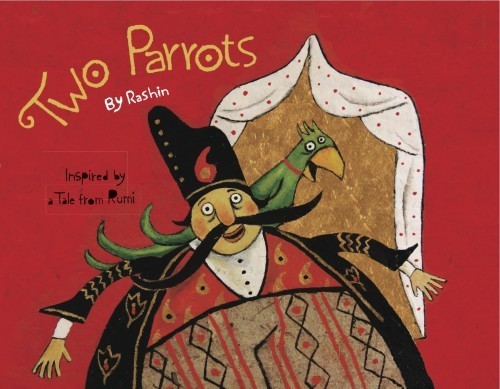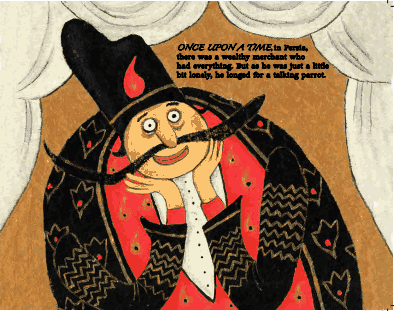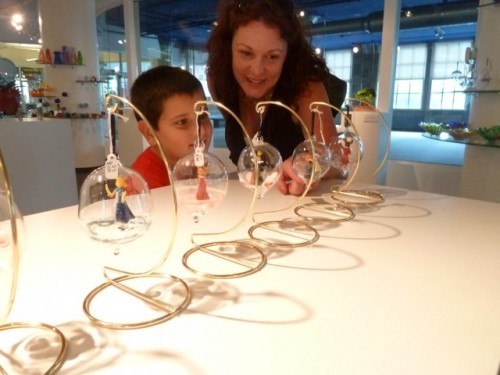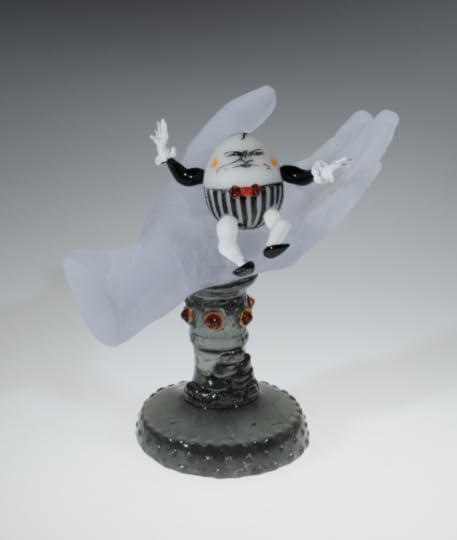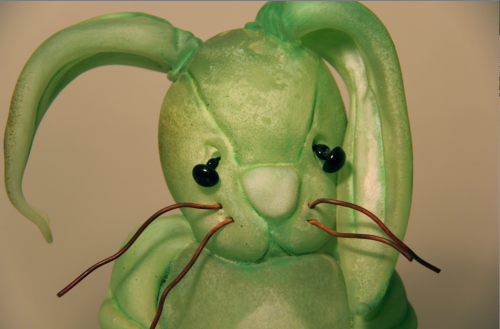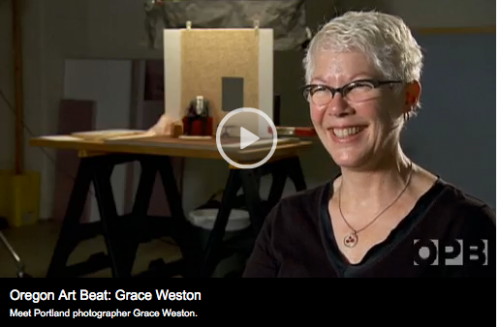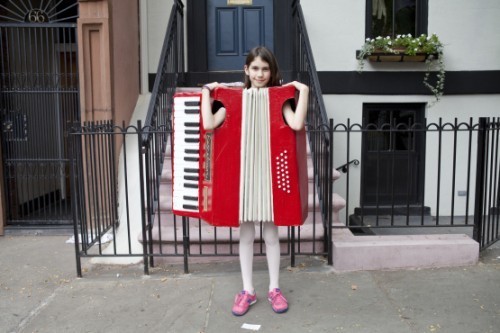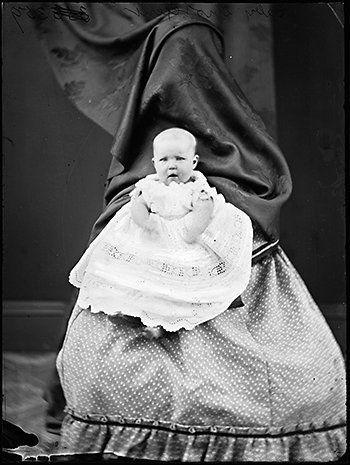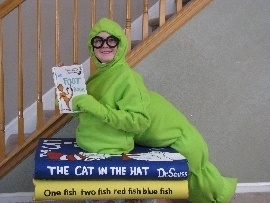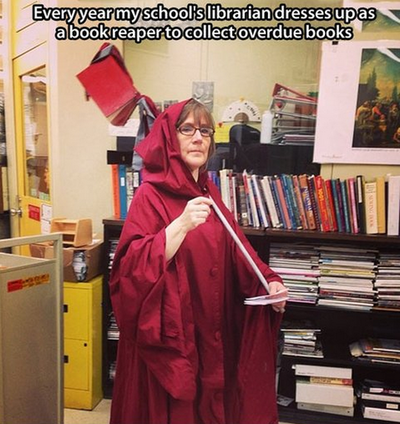Betsy Bird's Blog, page 301
November 7, 2013
Press Release Fun: “The Nitty Gritty” at Bank Street
Admittedly this is happening this Saturday, so your window of opportunity is closing fast. That said, it sounds dee-lightful. Check out what the Bank Street College of Education has on the roster:
Saturday, November 9, 2013
Writers Lab Mini-Conference 2: “The Nitty Gritty”
8:30-9:00AM Registration and Coffee
9:00-9:30AM Opening Keynote – Beth Kephart on the Teaching of Truth
9:30-10:10AM On Reviewing – Roger Sutton from The Horn Book, Vicky Smith from Kirkus Reviews, Luann Toth from School Library Journal and Sarah Smith, children’s editor of The New York Times Book Review.
10:15-11:00AM Breakout Discussion on “Mentor Texts”
Please select from the list of discussion leaders.
11:00AM to 12:00PM Autographing Session
Conference fee: $50
Note: The one-on-one critique appointments are now filled, but it’s a terrific morning chock full of great speakers and ideas.
- – - – -
Link to Discussion leaders:
Link to Registration:
November 6, 2013
Review of the Day: Happy Punks 1 2 3 by John Seven and Jana Christy
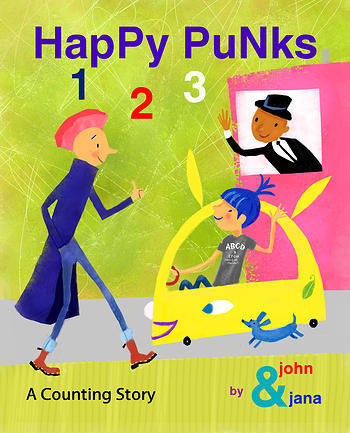 Happy Punks 123: A Counting Story
Happy Punks 123: A Counting Story
By John Seven and Jana Christy
Manic D Press
$15.95
ISBN: 978-1-933149-67-7
Ages 3-6
On shelves now
Here is how, as of the date of this review, Wikipedia defines the term “punk culture”. Ahem. “. . . largely characterized by anti-establishment views and the promotion of individual freedom.” Now look at your toddler. Go on. Give that kiddo a long, lingering look. Consider, for a moment, what makes a small child a small child. Do they believe in individual freedoms? Anyone who has ever attempted to herd a group of them will immediately answer yes. Are they anti-establishment? Well, what would YOU call the kid who draws on the hallways walls in permanent marker? Ladies and gentlemen the only logical explanation to draw from any of this is that toddlers are, and have always been, punk rockers. They have crazy hair, they create one-of-a-kind outfits of their own making, and they certainly have no problem with loud volumes. The evidence is extraordinary. It seems only fitting to hand them a counting book that displays as many different kinds of punks as possible. Looking for the mildest of subversions with a consistently sweet undercurrent, kickin’ art, and fun text? This punk’s for you.
A single, solitary, mohawked punk of the wide cuffed, purple coated, army boot variety goes walking down the street. He runs into his blue haired pal Noriko, she of the bunny-eared car, and then there are two. They, in turn, meet up with green dredded Kevin and the start jamming. It isn’t long before they’re getting ready for a big show, putting up posters, and getting everyone in town involved. More and more punks join the fun until by the slam-bang finish you’ve a party of twelve plus all their madcap friends. At long last it’s time to go home (even Noriko’s car seems to have conked out) and twelve happy punks sleep the night away.
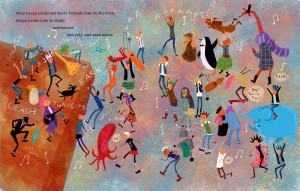 If you have a toddler you read a lot of counting books. It’s part of the deal you sign when the hospital hands over your kid for the first time. “I solemnly swear to read my child an ungodly amount of counting books until the seas turn a boiling roiling red.” Or words along those lines. And when you read a lot of counting books certain patterns start to emerge. You get the distinct feeling that all counting books rhyme in some manner. I don’t know why this should be. It’s not like every children’s book author is actually GOOD at rhyming. They just usually feel obligated to give it a go. So many of them do this, in fact, that when one encounters a picture counting book that does NOT rhyme in any way, shape, or form, the adult reader is thrown. You want to make the cadences even, but the book fights you every step of the way. Such was my experience with “Happy Punks 123”. The first lines are “One happy punk looks around for his friends.” Even before you turn the page you’re attempting to predict the next line. Will it be “Two happy punks now peer through a lens” or “Two happy punks will soon make amends”? Nope. It’s “Are they at Slobotnik Square? Or Calvin Corner?” Turn the page. “Two happy punks sit on a stoop. They like to watch cars and talk to dogs. Hey, is that Kevin?” You see? Other books have set up these weird expectations and you expect John and Jana’s latest to fit the mold. It’s sort of perfect that Happy Punks 123 bucks that expectation by doing its own thing. That’s real punk rock, man. Awesome.
If you have a toddler you read a lot of counting books. It’s part of the deal you sign when the hospital hands over your kid for the first time. “I solemnly swear to read my child an ungodly amount of counting books until the seas turn a boiling roiling red.” Or words along those lines. And when you read a lot of counting books certain patterns start to emerge. You get the distinct feeling that all counting books rhyme in some manner. I don’t know why this should be. It’s not like every children’s book author is actually GOOD at rhyming. They just usually feel obligated to give it a go. So many of them do this, in fact, that when one encounters a picture counting book that does NOT rhyme in any way, shape, or form, the adult reader is thrown. You want to make the cadences even, but the book fights you every step of the way. Such was my experience with “Happy Punks 123”. The first lines are “One happy punk looks around for his friends.” Even before you turn the page you’re attempting to predict the next line. Will it be “Two happy punks now peer through a lens” or “Two happy punks will soon make amends”? Nope. It’s “Are they at Slobotnik Square? Or Calvin Corner?” Turn the page. “Two happy punks sit on a stoop. They like to watch cars and talk to dogs. Hey, is that Kevin?” You see? Other books have set up these weird expectations and you expect John and Jana’s latest to fit the mold. It’s sort of perfect that Happy Punks 123 bucks that expectation by doing its own thing. That’s real punk rock, man. Awesome.
The art in this book is certainly shouldering a great big bulk of the fun. Nothing against the text. Even without its rhymes it’s a nice story of how one gathers friends throughout the day (without cell phones, which makes this downright utopian to some extent). But if the wrong illustrator had jumped on board this ship it would have meant the end of things. As it stands, the art has this laid back, friendly, colorful vibe. There are a lot of speech balloons and signs that mix script and print words. The very font of the book is of the typewriter variety and is snuggled seamlessly into the images. Design wise, the whole enterprise is a pleasure to the eye. It gets a little madcap near the end but with a premise of ever increasing punks you’d feel a bit cheated if it didn’t.
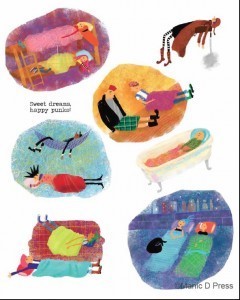 I also loved the subtle little jokes hidden along the way. On the cover, for example, you can see Noriko sporting a shirt that reads “ABCD & EFGH: Home of the Alphabet”. I’m no music guru. I won’t embarrass myself here by confessing how long it took me before I truly knew who Joey Ramone was. However, even I can recognize when a book might be making a reference to CBGB, the original punk rock music club of NYC. I also loved that it was a zombie running the music store (that could be a joke right there) and that they get their treats from “Ornery Penguin’s Gelato”. That’s not a reference to anything. It’s just the illustrator’s excuse to draw a testy penguin character. Who could blame them?
I also loved the subtle little jokes hidden along the way. On the cover, for example, you can see Noriko sporting a shirt that reads “ABCD & EFGH: Home of the Alphabet”. I’m no music guru. I won’t embarrass myself here by confessing how long it took me before I truly knew who Joey Ramone was. However, even I can recognize when a book might be making a reference to CBGB, the original punk rock music club of NYC. I also loved that it was a zombie running the music store (that could be a joke right there) and that they get their treats from “Ornery Penguin’s Gelato”. That’s not a reference to anything. It’s just the illustrator’s excuse to draw a testy penguin character. Who could blame them?
Since we’re dealing with the folks who created A Rule Is To Break: A Child’s Guide to Anarchy which earned its 15 minutes of fame when the Tea Party decided to make an example out of it, the inclination is to see whether or not John and Jana worked into a little subversion into the story. Did they? Well, I think it’s all in what you want to see. Yes, the sole antagonist in this book is an elephant. But go a little farther into the book and you’ll see he’s not the only elephant on the scene (a nice pink one works as a coat check girl at the club) and even if he were he joins the party at the end and has a wonderful time with the punks. So basically, Happy Punks 1 2 3 is a Rorschach test. You see in it what you want to see.
Basically this is a John Waters film made kid-friendly and picture book accessible. I don’t know that you’d necessarily call Waters “punk”, but then I don’t necessarily think you can slot Waters into any category all that easily. What this book really does is show a vast variety of different types of people, from hard-core rockers to straight edge hipsters. The punk aesthetic ideally celebrates all types of people, all the different ways they want to be (as long as they’re inclusive, obviously). And what John and Jana have done here is show that array, from robots to ultilikilted men to even elephants, if that’s what you’re into. The counting aspect works, and as per all potential bedtime books it ends with everybody asleep. From Portland to Williamsburg you’re bound to find folks loving the Happy Punks 1 2 3 vibe. It’s relentlessly cheery and the kind of book that makes you feel good after you finish it. World of counting books? Prepare to meet the latest, greatest addition to your fold.
On shelves now.
Source: Final copy sent from publisher for review.
Like This? Then Try:
Punk Farm by Jarrett Krosoczka
Dan, the Taxi Man by Eric Ode
Rat and Roach Rock On! by David Covell
Other Blog Reviews:
Punk Rock Parents
Cool Mom Picks
The Reader’s Gallery
Momma’s Bacon
Professional Reviews:
Kirkus
Publishers Weekly
Other Reviews:
Nerdy With Children
Chronogram
Misc: For the ebook version of this title complete with audio (no word on if there’s music), go no further than here.
Videos: Proof positive that counting and punk rock go hand in hand together.
November 5, 2013
Librarian Preview: NorthSouth Books (Spring 2014)
 There’s a special thrill that fills me when I get to do a librarian preview of a publisher I’ve never done before. It does me good. Though I like what the big guys produce, it’s the little guys that truly have my heart. Case in point, NorthSouth Books. If they’re a bit unfamiliar to you, don’t worry about it. Turns out they’re the U.S. arm of Zurich-based NordSüd Verlag. They were mostly doing imports but now they’ve started acquiring original titles here in the U.S. Oo de lally. For more info on the company I suggest you read the recent PW article A New Chapter for NorthSouth Books, which gives a mighty thorough and in-depth look at the company.
There’s a special thrill that fills me when I get to do a librarian preview of a publisher I’ve never done before. It does me good. Though I like what the big guys produce, it’s the little guys that truly have my heart. Case in point, NorthSouth Books. If they’re a bit unfamiliar to you, don’t worry about it. Turns out they’re the U.S. arm of Zurich-based NordSüd Verlag. They were mostly doing imports but now they’ve started acquiring original titles here in the U.S. Oo de lally. For more info on the company I suggest you read the recent PW article A New Chapter for NorthSouth Books, which gives a mighty thorough and in-depth look at the company.
So it was that Heather Lennon sat down with me to show me “the goods”, as it were, for the upcoming season. And sister, some of these are real doozies.
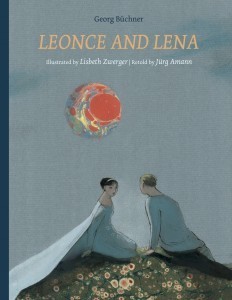 First up, we’re hitting you straight in the jugular. Leonce and Lena: A Comedy isn’t your average everyday book for kids. Written by Georg Buchner, illustrated by Lisbeth Zwerger and ultimately retold by Jurg Amann, the book is actually a German play. Reading it feels like nothing so much as a reading of The Fantastiks, which is an odd thing to say but I have my reasons. The story involves a prince and a princess engaged to be wed through an arranged marriage. Neither is particularly thrilled with the notion and through a series of misadventures they happen to flee, meet, and fall in love without realizing who the other is. The play was adapted here by “one of Switzerland’s most respected writers” and then Zwerger (who is famous in her own right) provided the gorgeous art. Since I live in New York and my young patrons often come in demanding plays and monologues for auditions and school shows, this certainly fits the bill.
First up, we’re hitting you straight in the jugular. Leonce and Lena: A Comedy isn’t your average everyday book for kids. Written by Georg Buchner, illustrated by Lisbeth Zwerger and ultimately retold by Jurg Amann, the book is actually a German play. Reading it feels like nothing so much as a reading of The Fantastiks, which is an odd thing to say but I have my reasons. The story involves a prince and a princess engaged to be wed through an arranged marriage. Neither is particularly thrilled with the notion and through a series of misadventures they happen to flee, meet, and fall in love without realizing who the other is. The play was adapted here by “one of Switzerland’s most respected writers” and then Zwerger (who is famous in her own right) provided the gorgeous art. Since I live in New York and my young patrons often come in demanding plays and monologues for auditions and school shows, this certainly fits the bill.
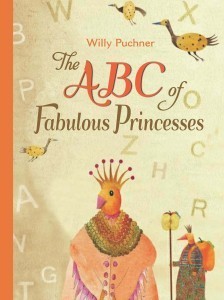 The ABC of Fabulous Princesses by Willy Puchner would, if you just said the name and did not see the cover, give you the impression that the book is one of those catalogs of princesses. We see these from time to time, usually European in origin, containing various flights of fancy where the likes of variegated royalty are concerned. The difference in the case of Puchner’s book (first published in Switzerland under the title ABC der fabelhaften Prinzessinnen) and those others may be the fact that everyone in this book is an anthropomorphized bird. But as Heather put it, “There’s no point in being a small publisher without stepping out sometimes.” So it is that we read the story of Prince William and his quest to find the princess that will make the best match. Each of the 26 is an alliterative lass. Here, for example, is what you find when you get to Princess Beatriz.
The ABC of Fabulous Princesses by Willy Puchner would, if you just said the name and did not see the cover, give you the impression that the book is one of those catalogs of princesses. We see these from time to time, usually European in origin, containing various flights of fancy where the likes of variegated royalty are concerned. The difference in the case of Puchner’s book (first published in Switzerland under the title ABC der fabelhaften Prinzessinnen) and those others may be the fact that everyone in this book is an anthropomorphized bird. But as Heather put it, “There’s no point in being a small publisher without stepping out sometimes.” So it is that we read the story of Prince William and his quest to find the princess that will make the best match. Each of the 26 is an alliterative lass. Here, for example, is what you find when you get to Princess Beatriz.
“Princess Beatriz comes from Bogota. She is bashful, bright, and at times badly behaved. She likes bacon, blueberries, and banana bread. Beatriz is a bibliophile and spends her time reading best sellers while her beagle barks in the bookstore. She brings Prince William blueprints of the brilliant Baron Bluebeak and his band of brothers.”
This is accompanied with lovely illustrations where everyone is a bird, one way or another. The child reader is then charged with determining William’s best match at the end. It’s oddly enticing.
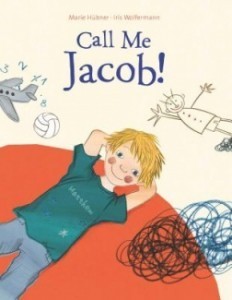 Call Me Jacob by Marie Hubner, illustrated by Iris Wolfermann is also originally of Switzerland but I can’t write out its original title because my computer doesn’t contain the correct characters. Now I don’t know about you, but in my library system there are a couple folks who have a distinct distaste for books with that distinctive European illustrative style. Jacob is obviously European when you first look at it, but inside the pictures have a very American flair (whatever that might be). The story concerns a boy named Matthew who wants to be called Jacob, a name which just happens to belong to his brave skateboarding cousin. As his week continues he appropriates the names of the boys who have talents and skills he desires. That is, until the moment he comes back around to good old Matthew. It’s sort of a My Name Is Yoon concept, but without the cross-cultural differences. Names have power, and part of what I like about the book is that it makes use of that understanding in a kid-friendly way.
Call Me Jacob by Marie Hubner, illustrated by Iris Wolfermann is also originally of Switzerland but I can’t write out its original title because my computer doesn’t contain the correct characters. Now I don’t know about you, but in my library system there are a couple folks who have a distinct distaste for books with that distinctive European illustrative style. Jacob is obviously European when you first look at it, but inside the pictures have a very American flair (whatever that might be). The story concerns a boy named Matthew who wants to be called Jacob, a name which just happens to belong to his brave skateboarding cousin. As his week continues he appropriates the names of the boys who have talents and skills he desires. That is, until the moment he comes back around to good old Matthew. It’s sort of a My Name Is Yoon concept, but without the cross-cultural differences. Names have power, and part of what I like about the book is that it makes use of that understanding in a kid-friendly way.
 At the moment the book I’m reading is the third Adam Gidwitz title that was released this past October, The Grimm Conclusion. So it’s all the more fitting to find myself learning about the upcoming picture book The Six Swans by the Brothers Grimm, illustrated by Gerda Raidt. Those of you who know the original story might shirk away a bit since there’s definitely a section or two in which an evil queen fingers a mute girl with the crime of cannibalism and infanticide. Fun! But actually, this version really lightens the story without coming across as inauthentic. You are probably familiar with the story of the girl with the brothers turned into swans and how she must never say a word as she knits them sweaters. In some versions she’s making the sweaters out of nettles. In this one it’s starflowers. At any rate, the art is great and the story really well told. I can say with certainty that we’ve never had a really good Six Swans picture book. Time to start!
At the moment the book I’m reading is the third Adam Gidwitz title that was released this past October, The Grimm Conclusion. So it’s all the more fitting to find myself learning about the upcoming picture book The Six Swans by the Brothers Grimm, illustrated by Gerda Raidt. Those of you who know the original story might shirk away a bit since there’s definitely a section or two in which an evil queen fingers a mute girl with the crime of cannibalism and infanticide. Fun! But actually, this version really lightens the story without coming across as inauthentic. You are probably familiar with the story of the girl with the brothers turned into swans and how she must never say a word as she knits them sweaters. In some versions she’s making the sweaters out of nettles. In this one it’s starflowers. At any rate, the art is great and the story really well told. I can say with certainty that we’ve never had a really good Six Swans picture book. Time to start!
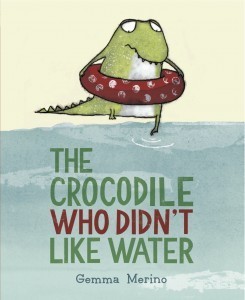 The Crocodile Who Didn’t Like Water is by Gemma Merino is adorable, but not in the treacly, sickly sweet sense. It follows a family of crocodiles and the one who simply does not care much for aquatic . . . . anything. He can’t play with his brothers and sisters or swim well or anything. When he gives it all he has and fails he’s left with a little cold. A little fire-breathing cold. Turns out, he’s not a crocodile at all but a dragon. “And this little dragon wasn’t meant to swim. He was born to fly.” Human nature naturally inclines towards stories of outcasts that come into their own. This one is perfect. It sort of reminded me of Guji Guji but it’s a bit better in terms of telling a story about embracing your own differences, no matter what they might be.
The Crocodile Who Didn’t Like Water is by Gemma Merino is adorable, but not in the treacly, sickly sweet sense. It follows a family of crocodiles and the one who simply does not care much for aquatic . . . . anything. He can’t play with his brothers and sisters or swim well or anything. When he gives it all he has and fails he’s left with a little cold. A little fire-breathing cold. Turns out, he’s not a crocodile at all but a dragon. “And this little dragon wasn’t meant to swim. He was born to fly.” Human nature naturally inclines towards stories of outcasts that come into their own. This one is perfect. It sort of reminded me of Guji Guji but it’s a bit better in terms of telling a story about embracing your own differences, no matter what they might be.
Two Parrots by Rashin Kheiriyeh is inspired by a story by Rumi. If that sounds vaguely familiar (parrots… Rumi…) it may be because a couple of years ago Disney/Hyperion published The Secret Message by Mina Javaherbin, which is based on the same story. The advantage Rashin has here is the art. Because there are certain madcap books that just earn my love in the strangest of ways. Here’s a good example. Check out the cover of this book:
Now check out the very first image we receive of the wealthy merchant (I apologize for the quality, which will be much higher in the final product):
Jon Scieszka once explained that the genius of David Shannon’s work on Robot Zot lay in part in the fact that he made the pupils in the eyes of his hero two different sizes. Nothing conveys wackiness better than that. In this story a parrot and his kin must trick a greedy merchant using their wits. It’s charming.
I think it’s always a good idea to wrap-up a preview with something jaw-dropping. Problem is, most previews don’t provide you with that particular thrill. Fortunately, this time around NorthSouth came through with flying colors. This book trailer is your required watching of the day.
It’s An American Tail meets The Arrival.
Lindbergh by Torben Kuhlmann is German originally and it is undoubtedly one of the most gorgeous little books I’ve seen in a very long time. As you could see from the trailer, a single mouse wishes to escape across the ocean. Cats and owls attempt to stop him but through trial and error he finally hits on the ideal mouse-sized flying machine. The art brings to mind illustrators like Bagram Ibatoulline or Robert Ingpen. Always great to have a new name to play around with. And a new book, for that matter. Here’s the cover:
Thanks again to Heather for sitting down with me and showing me these lovely wares! Spring cannot come fast enough.
November 4, 2013
Kidlit Glass Menagerie: A Delicate Children’s Literature Exhibit
Fun fact. A show of hands even. How many of you are aware the that the nonprofit National Center for Family Literacy has a brand new, bright and sparkling, name? Not I, said the fly. From here on in they are to be known as the National Center for Families Learning. Got that? Good, because it’s pertinent to today’s post. You see, the newly christened NCFL has paired together with Flame Run, a gallery in Louisville, Kentucky, and the result is the “Book Worm” glass exhibit. Which is to say, a range of artists working in the medium of glass brought to life their favorite characters and moments from children’s literature. As they say:
“It is our hope to use the mystery of glass art to inspire the magic of reading and learning. In “Book Worms” the ancient techniques of glass blowing will combine this historically social art activity with storytelling and an emphasis on family literacy. The exhibit will have a reception on November 1 from 6:00-9:00pm in celebration of National Family Literacy Day®. The glass studio will be open and families can sign up to blow their own glass ornaments; a portion of proceeds from all ornaments blown on November 1 benefit NCFL.”
And the pieces themselves? Well they range between . . .
ALICE IN WONDERLAND
CURIOUS GEORGE (IN SPACE, NO LESS)
BUNNICULA (WHICH VERGES ON THE BRILLIANT)
THE GOLDEN SNITCH
HUMPTY DUMPTY
AND THE VELVETEEN RABBIT
Beautiful!
Here is a complete listing of the authors and their works as well:
TITLE /ARTIST/ INSPIRATION
· ”The Monster Book of Monsters”, by Tiffany Ackerman, inspired by J.K. Rowling’sHarry Potter and the Prisoner of Azkaban
· ”Pinocchio”, by Dean Allison, inspired by Carlo Collodi’s The Adventures of Pinocchio
· ”The Giving Tree”, by Devyn Baron, inspired by Shel Silverstein’s The Giving Tree
· ”Astronaut George”, by Jason Chakravarty, inspired by H.A. Rey’s Curious George and the Rocket
· ”Green Eggs and Ham”, by John Chakravarty, inspired by Dr. Seuss’ Green Eggs and Ham
· ”Rudolph”, by Bob Cox, inspired by Robert L. May’s Rudolph the Red Nosed Reindeer
· ”Where the Red Fern Grows”, by Robin Hoerth, inspired by Wilson Rawls’, Where the Red Fern Grows
· ”Bunnicula”, by Evan Lolli, inspired by James Howe’s Bunnicula
· ”Harold and the Purple Crayon”, by Courtney Krammer, inspired by Crockett Johnson’s Harold and the Purple Crayon
· ”Untitled” by Patrick Martin, inspired by J.R.R. Tolkien’s The Hobbit
· ”Alice in Wonderland”, by Steve Scherer, inspired by Lewis Carroll’s Alice’s Adventures in Wonderland
· ”Hakken-Kraks Howl”, by Andy Schultz, inspired by Dr. Suess’ Oh the Place’s You’ll Go!
· ”Incognito” by Nicole Stahl, inspired by Don & Audrey Woods’ The Big Hungry Bear, The Little Mouse, and the Red, Ripe, Strawberry
· ”Honey Trouble” by Sergio Vettori, inspired by A.A. Milne’s Winnie the Pooh
· ”Humpty” by Jennifer Umphress, inspired by L. Frank Baum’s Humpty Dumpty
· ”Some Pig” by Dorie Gutherie, inspired by E. B. White’s Charlotte’s Web
· ”The Book of Kells” by Eoin Breadon, inspired by the Illuminate Manuscript, The Book of Kells
· ”The Velveteen Rabbit” by Amy Pender, inspired by Margery Williams’ The Velveteen Rabbit
· ”Burnt” by Lea Pate, inspired by Peter Yarrow and Lenny Lipton’s Puff the Magic Dragon
A thousand thanks to Sara Crumley for passing along the info and photos. If you live anywhere near Louisville, go to this thing. Sure wish I could.
November 3, 2013
Video Sunday: Everything in this post reeks of awesome
Took me a couple minutes to get into this one, but once I remembered the premise it helped. This is basically The Wizard of Oz redone with pop songs. A lot of which, sad to say, I have never heard of. Fortunately I could at least recognize the weird genius of the line, “You’re just a lion on the cold hard ground” from Taylor Swift’s “Trouble”. I’m not completely out of it. Plus you should check out The Wizard himself. A more badass Wiz I’ve yet to see.
Thanks to Marci for the link.
Next up, I’m just a tiny bit mad that there was a trailer for Boxers & Saints out there that was THIS GOOD and yet it took me roughly six months to discover it on my own. Your required watching of the day:
Um . . . may I work for Chronicle now? Please? I mean seriously . . . pretty please? No, honestly. I would work for you. Make me an offer. This video? I want to go to there.
http://www.youtube.com/watch?v=AFClUu...
The sole fault that I can find is that they do not properly credit everyone by name at the end. That is a mistake. I want to know who these folks are.
The Scholastic Reading Club blog Book Box Daily has a tendency to produce adorable videos. None so adorable as this, though. Here we have my friend Lori. Short of showing you puppies romping on a field, I could not display anything quite as cute. Particularly when she involves her siblings in her readings.
Finally, our off-topic video. I confess that had Stephany Aulenback not posted this on her blog Crooked House I probably would never have heard of artist Grace Weston at all. This might as well be called “Grace Weston: The artist you’d actually like to meet and hang out with for long periods of time”. Stephany says she has a “Mr Roger’s Neighborhood and Hieronymous Bosch” sensibility, and I see that but for me she’s filling the gap that The Far Side left in our hearts when Gary Larson fled the scene.
“. . . and then the laundry gets destroyed by ash!” *laughs hysterically*
Awesome. Thank you, Stephany for the link.
November 1, 2013
Press Release Fun: A Celebration of the 10th Anniversary of The New York Review Children’s Collection
October 31, 2013 (New York, NY) –To mark the 10th anniversary of The New York Review Children’s Collection, Edwin Frank, editor of NYRB Classics and The New York Review Children’s Collection series, will moderate a discussion with children’s literature experts George Nicholson, Susan Hirschman, Nancy Gallt, Ellen Handler Spitz, and Betsy Bird. They will talk about the changing character of children’s books.
About the Panelists:
Betsy Bird is the Youth Materials Specialist of New York Public Library and reviews for Kirkus and The New York Times. Her first picture book Giant Dance Party debuted this year and her new title Wild Things: Acts of Mischief in Children’s Literature will be published by Candlewick in 2014.
Edwin Frank is the editorial director The New York Review Children’s Collection and NYRB Classics series.
Nancy Gallt worked in subsidiary rights at Viking, HarperCollins Children’s Books, Morrow Junior Books, Greenwillow, and Lothrop Lee & Shepard before founding her own literary agency, where she represents a wide range of children’s book authors and illustrators, including Rick Riordan, and Sophie Blackall.
Susan Hirschman worked as an editor at Macmillan and with Ursula Nordstrom at Harper, before founding Greenwillow Books in 1974. At Greenwillow, she represented a varied list of writers and illustrators including best-selling author of the Mouse Books series, Kevin Henkes.
George Nicholson founded Delacorte Press and Yearling Books and was Publisher of Books for Children at The Viking Press and Bantam Doubleday Dell Books, before joining Sterling Lord Literistic as a literary agent. His clients include Zilpha Keatley Snyder, Joan Bauer, Leonard Marcus, Rune Michaels, Betsy Byars, Jan Greenberg, and Sandra Jordan.
Ellen Handler Spitz is an author, lecturer, and scholar who currently holds the Honors College Professorship of Visual Arts at University of Maryland, Baltimore County. She is the author of several books, including Inside Picture Books, and reviews children’s books for The New Republic.
Event Time and Location:
6 PM, Sunday, November 10th at McNally Jackson Books, 52 Prince Street, NY NY 10012
212-274-1160, www.mcnallyjackson.com. A reception will follow the discussion.
For more information about the McNally Jackson event or the 10th Anniversary, please contact Linda Hollick, New York Review Books, 212-293-1637, lhollick@nybooks.com
October 31, 2013
Happy Halloween: Boo!
Boy, it truly was Devil’s Night yesterday. Actually, it appears that my calling October 30th “Devil’s Night” is a clear cut case of showing how Michiganian I am. Who knew? At any rate, I had a whole post written up and boy it was beautiful. Tons of videos and pictures. The whole kerschmozzle. Then it disappeared *poof!* like that. Now I’m just going to hit the highlights. To wit:
If you’re looking for scary book recommendations, Katie Davis was kind enough to host me on her Brain Burps About Books podcast. The episode permalink is here and the iTunes link is here.
Tad Hills is best known for his Duck & Goose book series but he should be equally well known for the crazy cardboard costumes he made for his kids (think Michel Gondry but crazy good). Now TimeOut Kids New York has highlighted some of the best he’s done. This one is my personal favorite.
Ghostbusters meets Dr. Seuss.
A sweet skeleton love story that’s appropriate for the day. WARNING: There is some skeleton sex during the credits. Just FYI.
Spike Jonze: Mourir Auprès de Toi on Nowness.com
The scariest picture book Albert Whitman & Co. ever published for kids is also, by extension, the most awesome. Paging the Gallery of Regrettable Foods . . .
In the days when you had to sit stock still for any and all photos, mothers would be disguised with fabric, making for some very odd shots. Retronaut has the collection.
Thanks to Lisa Brown for the link.
Bookworm!
Thanks to Playing By the Book for the link.
Monster alphabet!!
ABC monsters from La Pompadour on Vimeo.
Hmm. Not a bad idea.
Thanks to Marci for the link!
And now a friendly book trailer as well:
The sole flaw with The Ten Best Read Aloud Halloween Picture Books for Kids? How the heck they define some titles as “picture books”.
And while we’re thinking of it, James Howe lays out the best children’s book Halloween costumes for you.
Happy Halloween!
October 30, 2013
Review of the Day: When Thunder Comes by J. Patrick Lewis
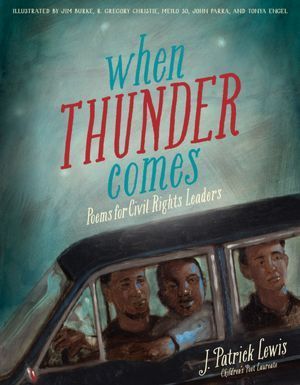 When Thunder Comes: Poems for Civil Rights Leaders
When Thunder Comes: Poems for Civil Rights Leaders
By J. Patrick Lewis
Illustrated by Jim Burke, R. Gregory Christie, Tonya Engel, John Parra, and Meilo So
Chronicle Books
$16.99
ISBN: 978-1-4521-0119-4
Ages 10 and up
On shelves now
Poetry is of the people by its very definition. Though sometimes considered the property of the elite (usually by folks who were forced to eat poetry unfiltered in high school by bored teachers) at its best it is a format that any human with a sense of rhythm and/or timing can use to their advantage. Poetry is the voice of people who are oppressed. When Chinese immigrants found themselves detained for weeks on end on Angel Island, they scratched poetry into the very walls of the building. Not curses. Not cries. Poems. It seems fitting then that J. Patrick Lewis should cull together poems to best celebrate “civil rights leaders” both known and unknown. People of different races, creeds, religions, and even sexualities are celebrated in a book that can only be honestly called what it is: one-of-a-kind.
Seventeen people. That doesn’t sound like a lot of folks. Seventeen people turning the tide of history and oppression. Seventeen individuals who made a difference and continue to make a difference every day. And to accompany them, seventeen poems by a former Children’s Poet Laureate. In When Thunder Comes, J. Patrick Lewis highlights heroes of every stripe. And, in doing so, lets young readers know what a hero truly is.
 Lewis isn’t phoning this one in. These poems are straight up honest-to-god works of poetry. Though the book is a mere 44 pages or so, its picture book size is misleading indeed. Consider this poem about Aung San Suu Kyi containing the following lines: “When a cyclone flicked off the roof of my prison / like the Queen of Hearts, turning my life to shame / and candle, the General had a mole removed. / When they added four words to the constitution – / my name – to bar me from ever running for office, / the General signed it with his fingernail made of / diamonds and disgust.” We’re on beyond nursery rhymes and patter here. There are also individual lines you just can’t help but admire. I like this one about Nelson Mandela in particular: “It is as if he’s landed on the moon / Five years before the actual event.”
Lewis isn’t phoning this one in. These poems are straight up honest-to-god works of poetry. Though the book is a mere 44 pages or so, its picture book size is misleading indeed. Consider this poem about Aung San Suu Kyi containing the following lines: “When a cyclone flicked off the roof of my prison / like the Queen of Hearts, turning my life to shame / and candle, the General had a mole removed. / When they added four words to the constitution – / my name – to bar me from ever running for office, / the General signed it with his fingernail made of / diamonds and disgust.” We’re on beyond nursery rhymes and patter here. There are also individual lines you just can’t help but admire. I like this one about Nelson Mandela in particular: “It is as if he’s landed on the moon / Five years before the actual event.”
The content is noticeably more mature as well. Kids have plenty of books to choose between when it comes to the Freedom Riders and Walkers, but the deaths of James Chaney, Andrew Goodman, and Michael Schwerner are dark as dark can be. That poem is told, not in broken up sections, but as a single long, square paragraph. Other ideas, like Muhammad Yunus and his microcredit system or Harvey Milk and his fight for gay rights require a bit more worldly knowledge on the part of readers.
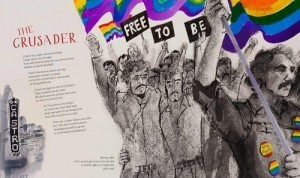 Lewis makes some interesting choices along the way. He’s careful to include familiar names (Gandhi, Nelson Mandela, Jackie Robinson, etc.) alongside lesser-known figures (Aung San Suu Kyi, Helen Zia, Ellison Onizuka, etc.). Some are living, some long dead. Each person has a title (“activist”, “auntie”, etc.). For “the innocent” he names Mamie Carthan Till but not her son, Emmett. At first I was confused by the choice, but the end matter made it clear that it was Mrs. Till that insisted that her son’s funeral be an open casket affair. An act of rebellion in and of itself. And this is undoubtedly the first book for children I’ve read that made special note of Harvey Milk. I know that some smaller presses have highlighted him in the past, but it’s particularly satisfying in this day and age to see him properly named and credited. A sign of the times, if you will.
Lewis makes some interesting choices along the way. He’s careful to include familiar names (Gandhi, Nelson Mandela, Jackie Robinson, etc.) alongside lesser-known figures (Aung San Suu Kyi, Helen Zia, Ellison Onizuka, etc.). Some are living, some long dead. Each person has a title (“activist”, “auntie”, etc.). For “the innocent” he names Mamie Carthan Till but not her son, Emmett. At first I was confused by the choice, but the end matter made it clear that it was Mrs. Till that insisted that her son’s funeral be an open casket affair. An act of rebellion in and of itself. And this is undoubtedly the first book for children I’ve read that made special note of Harvey Milk. I know that some smaller presses have highlighted him in the past, but it’s particularly satisfying in this day and age to see him properly named and credited. A sign of the times, if you will.
Another thing I like about the book is its ability to highlight individuals that should be, and are not, household names. If Sylvia Mendez truly paved the way for Brown v. Board of Education, why isn’t Mendez v. Westminster better known? Certainly the book is ideal for writing assignments. The poems vary in terms of style, and I can see teachers everywhere assigning even more too little lauded heroes to their students, asking them to cultivate poems of their own. It would have been nice if somewhere in the book it said what the types of poems featured were (villanelles don’t come along in children’s books every day, after all). Teachers hoping to make connections between some of the subjects then and now might also point out things like how Emmett Till bought candy prior to his death, not unlike a more contemporary hoodied young man.
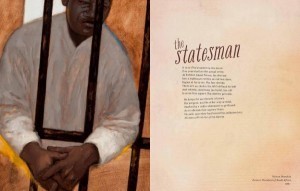 Of the various objections I’ve heard leveled against this book, there is the problem that each piece of art is not directly credited to its artist. Meilo So’s style is recognizable enough. Ditto R. Gregory Christie. But who did that image of Josh Gibson? Or Dennis James Banks for that matter? Now, the artists are listed on the publication page with references to their images, but since the book itself isn’t paginated this isn’t as useful as it might be. And some of the images work better than others, of course. While I wasn’t as taken with the images of Coretta Scott King, Mamie Carthan Till, or Dennis James Banks, I really liked Josh Gibson wearing his “Grays” garb, standing against a sky full of clouds. A different librarian objected to the fact that the three men murdered by the Klan in 1964 are featured with very similar, dark skin tones. I see the point, but since the shot is taken at night and the whole of the image is itself dark, this didn’t worry me as much.
Of the various objections I’ve heard leveled against this book, there is the problem that each piece of art is not directly credited to its artist. Meilo So’s style is recognizable enough. Ditto R. Gregory Christie. But who did that image of Josh Gibson? Or Dennis James Banks for that matter? Now, the artists are listed on the publication page with references to their images, but since the book itself isn’t paginated this isn’t as useful as it might be. And some of the images work better than others, of course. While I wasn’t as taken with the images of Coretta Scott King, Mamie Carthan Till, or Dennis James Banks, I really liked Josh Gibson wearing his “Grays” garb, standing against a sky full of clouds. A different librarian objected to the fact that the three men murdered by the Klan in 1964 are featured with very similar, dark skin tones. I see the point, but since the shot is taken at night and the whole of the image is itself dark, this didn’t worry me as much.
In many ways the book most similar to this is Marilyn Singer’s recent Rutherford B., Who Was He?: Poems About Our Presidents Like Singer’s book, Lewis presents the poems and people first and then provides an explanation of who they were at the end. Both give new slants on old names. But for all that, Lewis’s book is unique. Maybe not 100% perfect, but chock full of better poetry than you’ll find in a lot of children’s rooms, highlighting folks that deserve a little additional attention. Certainly bound to be of use to teachers, parents, and kids with an eye towards honest-to-goodness heroism. A lovely addition, no matter where you might be.
On shelves now.
Source: Reviewed from library copy.
Like This? Then Try:
We Are America by Walter Dean Myers
This Is the Dream by Diana ZuHone Shore
Rutherford B: Who Was He?: Poems About Our Presidents by Marilyn Singer
October 29, 2013
Press Release Fun: Books About Bullying, a Google+ Hangout
Hi, folks! Here’s a thing I’m doing on Monday, November 4th. Come see me and a bevy of talented authors on a topic that I’m going to handle in a new way.
Books about Bullying: A Google+ Hangout
(or Bullying Prevention: How Books Can Help)
The New York Public Library hosts a special on air Google+ Hangout on overcoming bullying, how books can help, and aspiring to do more.
Our panel of authors and artists share their own personal struggles with bullies and they learned to cope. Guests include Tim Federle, Eric Kahn Gale, and Laura Vaccaro Seeger. Moderated by NYPL’s Elizabeth Bird.
Tune in Monday, November 4, 2013 at 3 pm. Go here to sign up!
—
More about our guests:
Betsy Bird: Bird is a librarian, blogger with SLJ (at A Fuse #8 Production), and a reviewer for Kirkus and The New York Times. Her first picture book Giant Dance Party was released this spring and her next book is the very adult Wild Things: Acts of Mischief in Children’s Literature which she co-wrote with Jules Danielson and Peter Sieruta.
Tim Federle: Federle was born in Foster City, California and was later raised in Upper St. Clair, Pennsylvania. He made his professional debut at age 12 in a production of Oliver! directed by Rob Marshall. He then went on to perform in several Broadway shows before penning his first novel, Better Nate Than Ever, a middle grade novel about an eighth-grader who dreams of performing in a Broadway musical and who concocts a plan to run away to New York to audition for the role of Elliot in the musical version of “E.T.”
Eric Kahn Gale: Michigan native Eric Kahn Gale originally self-published his middle grade novel The Bully Book on his own, before it was picked up by Harper Collins. The book is loosely based on incidents that happened to him in sixth grade through the lens of a mystery novel. His character, Eric Haskins, doesn’t take his situation lying down; he searches for the answers and unlike many of us who went through something awful, he finds them. Though they’re not what he expected.
Laura Vaccaro Seeger: Laura Vaccaro Seeger is an Emmy-award winning artist and the critically acclaimed author and illustrator of “The Hidden Alphabet,” “Lemons are Not Red,” and “Walter Was Worried.” All were named ALA Notable Books and “Child Magazine” Best Books of the Year. Her picture book “Green” won a Caldecott Honor from the American Library Association in 2013.
October 28, 2013
Fusenews: Pretty sneaky, sis.
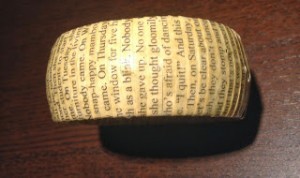 I have a sister. Did you know that? Tis true. She’s not a librarian and her interest in children’s literature pretty much begins and ends with me, which is probably why she hasn’t come up before. One thing she is? Crafty. Crafty as all get out. And the kicker is that she’s just started this new blog called The How To, How Hard, and How Much to Your Creative Products. Here’s how she describes it:
I have a sister. Did you know that? Tis true. She’s not a librarian and her interest in children’s literature pretty much begins and ends with me, which is probably why she hasn’t come up before. One thing she is? Crafty. Crafty as all get out. And the kicker is that she’s just started this new blog called The How To, How Hard, and How Much to Your Creative Products. Here’s how she describes it:
What if there was a blog out there that took Pinterest ideas and showed people how to do it, how much time it took, how much money was spent, and had a level of expertise (1-5). Maybe even sell the final product. Is this something people would read? Has it already been done? How could I rope guys into doing it (other than if it involved mustaches and bacon)? I’ve never blogged before but I feel like it might be helpful, especially since the holiday season is quickly approaching. People could even send me recommendations and I could do those as well.
And make it she has. Amongst other things she has a wide range of Halloween ideas including spider cookies, 5 minute ideas, and my personal favorite, the cleaver cupcakes. In fact, if you could just repin those cupcakes onto your Pinterest boards she’d be mighty grateful (there’s a contest she’s entering them into). But of special interest to the blog (aside from outright nepotism) was her recent posting on literary jewelry where she turned a book of mine into a bracelet. Nicely done, l’il sis.
I attended the Society of Illustrators event the other day (did you know the place is free on Tuesdays?!) and the New York Times Best Illustrated results are on the cusp of an announcement soon. Both lists are chosen by artists as well as librarian types, and so one could consider them the form with which artists are allowed to voice their opinions about the best of the year (just as the National Book Awards are how authors talk about writing). Still, there are those that have disliked the Caldecott from the outset because it is decided not by artists but librarians. Robin Smith recently dug up a 1999 interview with Barry Moser voicing just such a concern. A hot little discussion then emerged in the Horn Book comments. Go! See!
Brian Biggs + Jon Scieszka + 6 way auction = interesting.
Our first shout-out! And from Tomie dePaola, no less. On The Official Tomie dePaola Blog you will find a lovely mention of the upcoming Wild Things: Acts of Mischief in Children’s Literature as penned by myself, Jules Danielson, and Peter Sieruta. Woot!
I think a fair number of us have seen Business Insider’s Most Famous Book Set in Every State map by this point, but I’d just like to mention that what pleases me the most about it is the fact that they included children’s books as well as adult. Six children’s and one YA novel by my count.
Let’s Talk About Dav Pilkey, Captain Underpants, and Misogyny. So says author Lynn Messina. Interesting title, no?
And since we’re on an interesting title kick, let’s throw out another one. True or False? Multicultural Books Don’t Sell. We’ve all heard that argument before. Now an actual honest-to-god bookseller tackles the question. You may normally know Elizabeth Bluemle from the ShelfTalker blog at PW, but here she’s guest talking at Lee & Low. Cleverly, she specifies whether or not we are talking about how they don’t sell to kids or how they don’t sell to adults. Without giving anything away, let me just say that her experiences mirror my own in the library.
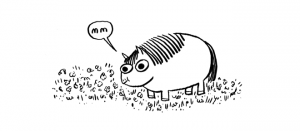 In other press release news, I am shocked and appalled that I wasn’t aware of this until now. I mean, I knew that Kate Beaton, the genius behind Hark, A Vagrant, was working on children’s books. What I did not know was how close to fruition my dream of shelving her in my children’s sections truly was. The Wired blog Underwire, of all places, was the one with the scoop when they interviewed Ms. Beaton. She discusses the book, which contains her most famous creation (the fat pony) and a princess. Says she about princesses in general, “. . . for little girls historically [princesses] are the only people like them who had any power at all. It’s not just oh, princes and dresses. It’s also, here’s a person with agency. Is she just someone who wants a pretty dress and prince? Or is she a warrior living in a battle kingdom? I think it just depends on how you depict what a princess is.” I think we know the direction Ms. Beaton will go in. And I waaaant it. Thanks to Seth Fishman for the link.
In other press release news, I am shocked and appalled that I wasn’t aware of this until now. I mean, I knew that Kate Beaton, the genius behind Hark, A Vagrant, was working on children’s books. What I did not know was how close to fruition my dream of shelving her in my children’s sections truly was. The Wired blog Underwire, of all places, was the one with the scoop when they interviewed Ms. Beaton. She discusses the book, which contains her most famous creation (the fat pony) and a princess. Says she about princesses in general, “. . . for little girls historically [princesses] are the only people like them who had any power at all. It’s not just oh, princes and dresses. It’s also, here’s a person with agency. Is she just someone who wants a pretty dress and prince? Or is she a warrior living in a battle kingdom? I think it just depends on how you depict what a princess is.” I think we know the direction Ms. Beaton will go in. And I waaaant it. Thanks to Seth Fishman for the link.
As slogans go, this might be one of my favorites: “Kill time. Make history”. How do you mean? Well, NYPL is looking for a few good bored folks. Say they, “The New York Public Library is training computers how to recognize building shapes and other information from old city maps. Help us clean up the data so that it can be used in research, teaching and civic hacking.” Sometimes I just love my workplace.
Me stuff time. Or rather, stuff I’m doing around and about the world that you might like to attend. You see, on November 6th I’ll be interviewing legendary graphic novelist Paul Pope at 4pm at the Mulberry Street library branch here in NYC. If you are unfamiliar with Mr. Pope’s name, all you really need to know is that he’s a three time Eisner Award winning artist who wrote the recent GN Battling Boy and whose work is currently on display at the Society of Illustrators on their second floor (which just means I get to tell you again that you can get in for free on Tuesdays). This event will also be free. If you’ve ever wondered what the “Mick Jagger of graphic novels” would look like, you’ll find out soon enough.
Also going on in NYC, they have transferred Allegra Kent’s Ballerina Swan to the stage for kids. Makes perfect sense when you put it that way.
This is utterly delightful. Recently Picture Book Month’s Education Consultant Marcie Colleen contacted me with this awesome PDF entitled Picture Book Month Teacher’s Guide: Why Picture Books Belong in Our Classrooms. It was so useful, in fact, that I tapped her for an upcoming Children’s Literary Salon about the Core Curriculum. More about that later, though . . .
My reaction to finding out that Henry Selick was going to direct Adam Gidwitz’s A Tale Dark and Grimm was simple. The best possible person is doing the best possible thing and is making everyone happy in the process. My sole concern? Selick’s going live action on this. What was the last live action film he directed? Monkeybone, you say? Ruh-roh. Thanks to PW Children’s Bookshelf for the link.
Daily Image:
Remember that nice Marcie Colleen I mentioned earlier with her Picture Book Month Teacher’s Guide? Well, turns out she’s engaged to Jonathan Lopes, the Senior Production Manager at Little, Brown. And amongst the man’s many talents is the fact that he occasionally sculpts with LEGOs. Recently Hachette “held their Gallery Project, showcasing the talents of their employees.” Here’s what Jonathan made.

He’s 6-feet-tall and all LEGO, baby. Many thanks to Marcie Colleen for the link!


